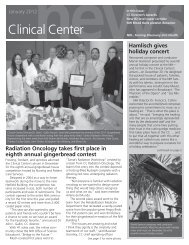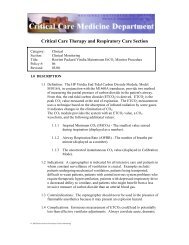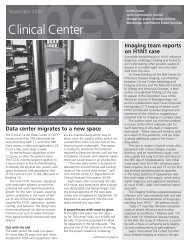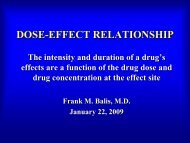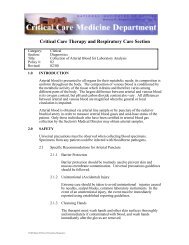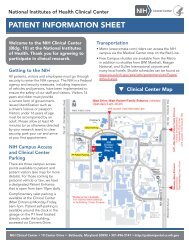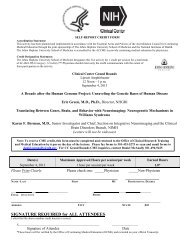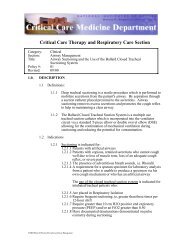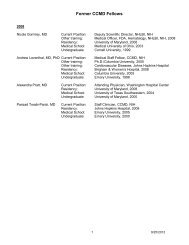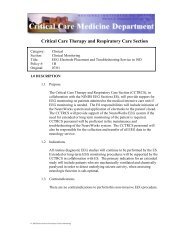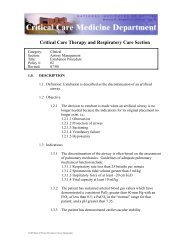2011 - NIH Clinical Center - National Institutes of Health
2011 - NIH Clinical Center - National Institutes of Health
2011 - NIH Clinical Center - National Institutes of Health
You also want an ePaper? Increase the reach of your titles
YUMPU automatically turns print PDFs into web optimized ePapers that Google loves.
possible trouble spots to only a few. Dr. ClaraChen, deputy chief <strong>of</strong> the nuclear medicinesection in Radiology and Imaging Sciences,was instrumental in deciphering which markshad potential and which were misleading,Collins said.With an idea <strong>of</strong> where the tumor may be, next toJones’ right tibia, Dr. Richard Chang, chief <strong>of</strong> theendocrine and venous services section, threadeda catheter down a vein in Jones’ leg and tookblood samples at different points to test presence<strong>of</strong> FGF23.The numbers spiked around the tumor.Jones was at her grandmother’s house whenCollins called with the news.When she heardthey’d found the tumor, she gave her grandmothera thumbs up.“She started screaming, she was sohappy,” Jones remembered.Dr. Felasfa Wodajo, medical director <strong>of</strong> Inova<strong>Health</strong> System’s Musculoskeletal Tumor Programand a consultant to the <strong>National</strong> Cancer Institute,removed the tumor in August. Recurrence is rare,especially when a large margin <strong>of</strong> surroundingtissue is removed, as was done with Jones.She is back in Washington, returning to life asa healthy teen.“I’m back on my swim team,which I really love,” she said.“I can walk in thehall without being worried about knocking intosomething.”The end result wasn’t due to fancy science, Collinssaid, just the meticulous, rigorous teamwork thatoccurs at the CC. “How <strong>of</strong>ten in medicine doyou get a chance to really cure someone? Thatwas fantastic.”Study could improve care forrare immune disease<strong>NIH</strong> investigators have observed that the survivalrate <strong>of</strong> people with a rare immunodeficiencydisease called chronic granulomatous disease(CGD) is greatly improved when even very lowlevels <strong>of</strong> microbe-killing molecules are present.Because production <strong>of</strong> these molecules, made by anenzyme called NADPH oxidase, can be predictedfrom genetic analysis, a patient’s risk for severeCGD could be assessed very early in life, allowingfor more personalized treatment, say the researchers.The study was conducted at the <strong>Clinical</strong> <strong>Center</strong>and led by researchers from the <strong>National</strong> Institute<strong>of</strong> Allergy and Infectious Diseases and their associatedlabs at SAIC-Frederick Inc.The study is availableonline in the New England Journal <strong>of</strong> Medicine.“Advances in treatment <strong>of</strong> CGD have made itpossible for people with this once-fatal disease <strong>of</strong>early childhood to survive into adulthood; however,the disease remains difficult to manage,” saidNIAID Director Dr.Anthony S. Fauci.“Having amarker to help predict disease prognosis will enablephysicians to recommend treatment optionsthat are more tailored to the needs <strong>of</strong> individualpatients.”People with CGD have increased susceptibilityto infections caused by certain bacteria and fungi.They can have abscesses in the lungs, liver, spleen,bones, or skin.Those with severe disease also canhave tissue masses, called granulomas, that can obstructthe bowel or urinary tract. CGD affects anestimated 1,200 people in the United States andapproximately 25,000 people worldwide.The disease is caused by inherited mutations inany one <strong>of</strong> five different genes required by immunecells to make the NADPH oxidase enzyme,which in turn makes superoxide, an oxygenderivedmolecule that immune cells use to destroyharmful bacteria and fungi.All CGD patients haveimpaired superoxide production, but some makea little superoxide, while others make none.Theresearch team found that the level <strong>of</strong> superoxideproduction was linked to the type <strong>of</strong> mutation inthe NADPH oxidase gene, and that the more superoxidea patient with CGD can make, the betterthe life expectancy.Until now, the severity <strong>of</strong> CGD has been linkedonly to how people inherit the NADPH oxidasegene mutation. If people inherit the mutation asan autosomal recessive trait, meaning that twocopies <strong>of</strong> the abnormal gene, one from each parent,are present, the disease has generally been lesssevere than in those who inherit the mutation asANNUAL REPORT <strong>2011</strong>• 35



